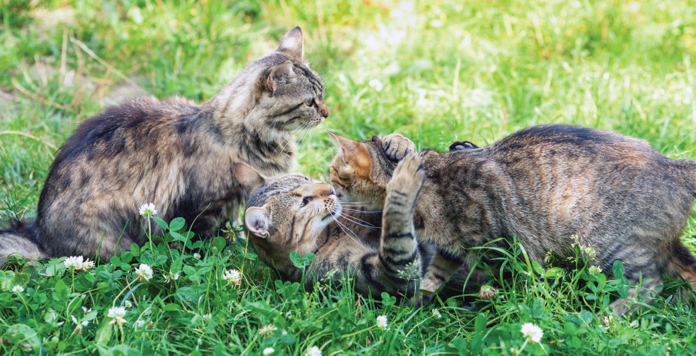Feline panleukopenia, sometimes referred to as feline distemper or FPV, is a feline parvovirus. Like other parvoviruses, this virus attacks rapidly dividing cells, such as those in a kitten’s bone marrow or intestines. Panleukopenia can wipe out immune-system cells, making affected cats more susceptible to other infectious diseases.
This virus is ubiquitous in the environment and very resilient, remaining viable for weeks to months. FPV is highly infectious and spreads rapidly through fecal material, urine, and nasal discharges. These qualities make catteries and shelters the perfect setting for outbreaks, and susceptible cats and kittens may become infected even after thorough disinfection of the area.
Panleukopenia virus enters a susceptible cat either by inhalation or orally. The virus starts to replicate in the tonsils and the tissues of the mouth. Next, it gets into the bloodstream. Clinical signs of illness tend to show up three to five days later, once the virus reaches target tissues. Luckily, there is a vaccine.
Symptoms
Severe diarrhea is the most obvious clinical sign. High fevers and vomiting may precede the diarrhea, along with anorexia and profound lethargy. Owners may report that their cat sits by the water but does not drink. Abdominal pain may be present.
Kittens infected in utero often develop cerebellar hypoplasia. They will exhibit ataxia (a lack of muscle control and coordination) that will not resolve. This is generally evident by about three weeks of age in affected cats. It is important to note, however, that although affected cats will show these signs for life, they can live happy lives provided that owners take measures to prevent their being injured by their disability and have them examined by a veterinarian regularly. Retinal problems also may be noted.
Kittens can receive passive immunity in the form of antibodies from their queen’s early mammary secretions (colostrum) if the queen has developed an effective immune response to this virus. Mortality rate is high in unprotected cats and kittens. The highest mortality, up to 90%, is seen in kittens up to 12 months of age, especially if they did not acquire maternal antibodies via colostrum ingestion.
Canine Parvo Is Similar
The feline version of parvovirus (FPV) is similar to the canine version. Currently, the dog virus can infect cats (although not common in North America) and the feline version can infect dogs, but in this case, there is no viral shedding. Large cats, including bobcats, lynx, lions, and tigers, and some wildlife species such as raccoons and mink can be infected with FPV. At this time, FPV has not been shown to infect humans.
Diagnosis
Diagnosis is achieved via antigen testing of fecal material. False negative results are common with these tests, as virus is only shed in the stool for a short time. A simple complete blood count (CBC) will often show very low concentrations of all the blood cells due to bone marrow damage. Rapid screening tests for canine parvovirus may also pick up cases of this feline parvovirus.
Treatment
There is no specific therapy for cats infected with feline panleukopenia. Instead, symptomatic and supportive care is important. Intravenous fluid for hydration and electrolyte balance is the most effective treatment. Dehydration can be severe and may be fatal.
With the intestinal barriers destroyed, many cats will get bacteria in their bloodstreams (septicemia), so antibiotics are recommended to fend off this possibility. Plasma or whole blood transfusions, B vitamin supplementation, and parenteral nutrition (nutrition provided intravenously) may also be helpful in some cases.
Feline recombinant interferon omega may be helpful, as can anti-FPV serum, but these have not been thoroughly tested in cats at this time. Feline recombinant interferon omega is not currently FDA-approved for cats, but this type of treatment has been shown to be effective in some cases of canine parvovirus infection.
Prevention
FPV vaccine is a core vaccine that is recommended for all cats. Modified live vaccines should not be used in pregnant queens or on very young kittens. The standard vaccine protocol is to vaccinate kittens at 8, 12, and 16 weeks of age, with booster vaccines at 1 year of age. One study, done by Ron Schultz PhD while at Cornell, showed that even with inactivated vaccine, immunity to FPV may last seven years or more in some cats. However, standard recommendations suggest a booster every three years out of an abundance of caution.
FPV is resistant to many common disinfectants, but it can be inactivated by products that contain peracetic acid, formaldehyde, sodium hypochlorite, or sodium hydroxide.
Isolation is important if you have a cat with FPV. The virus can be spread via bedding, food and water bowls, and even via your hands and clothing if you have handled sick cats. Parasites like fleas can also spread the virus within a colony of cats. Infected cats who recover should be thoroughly bathed to help eliminate any virus on their fur.
Always assume that stray cats are potentially infected with FPV. They should be isolated and vaccinated. Even indoor-only cats should be properly vaccinated. If you foster or volunteer at a shelter, make sure your own cats are properly immunized and practice good hygiene and isolation procedures.




